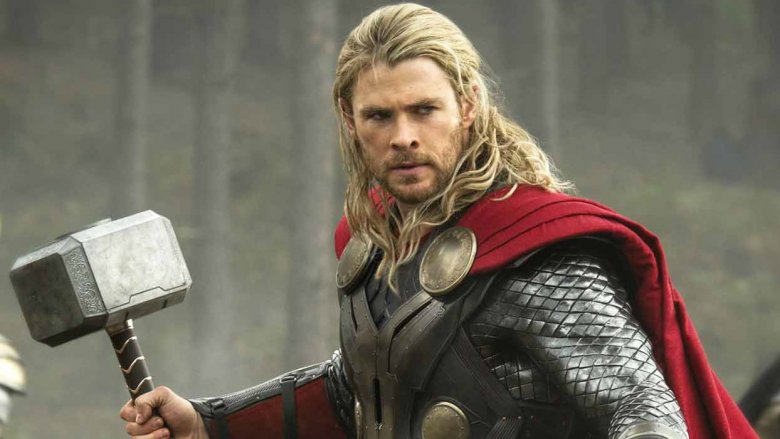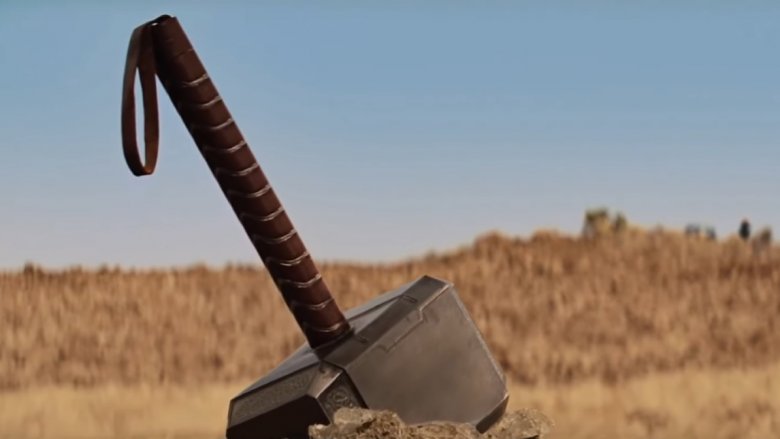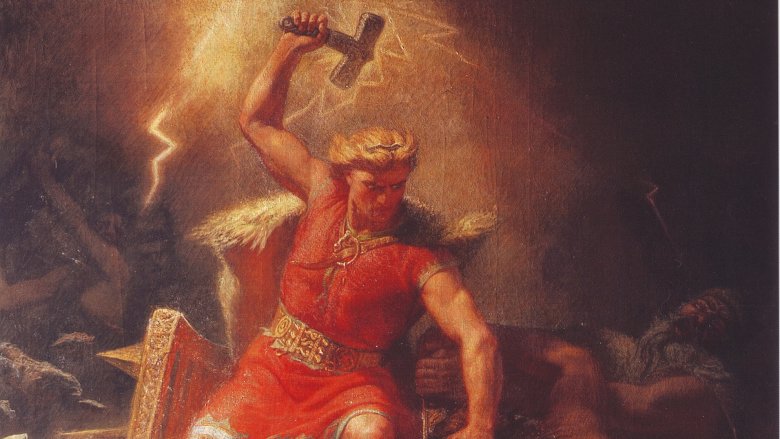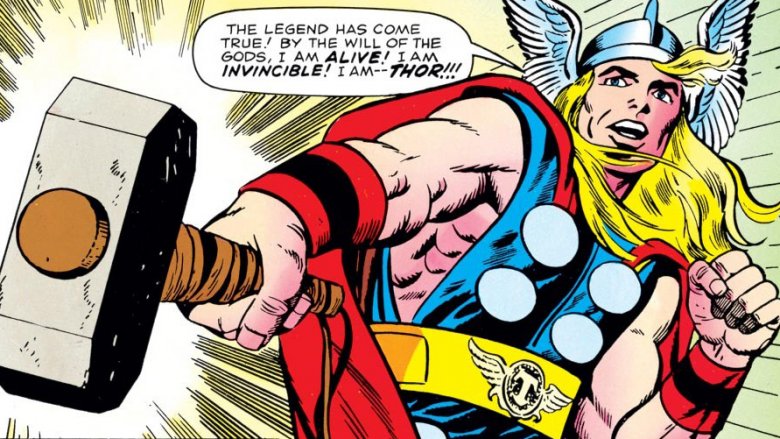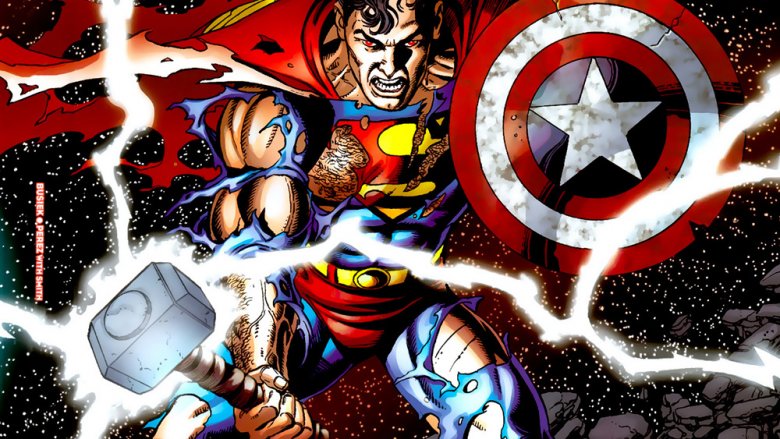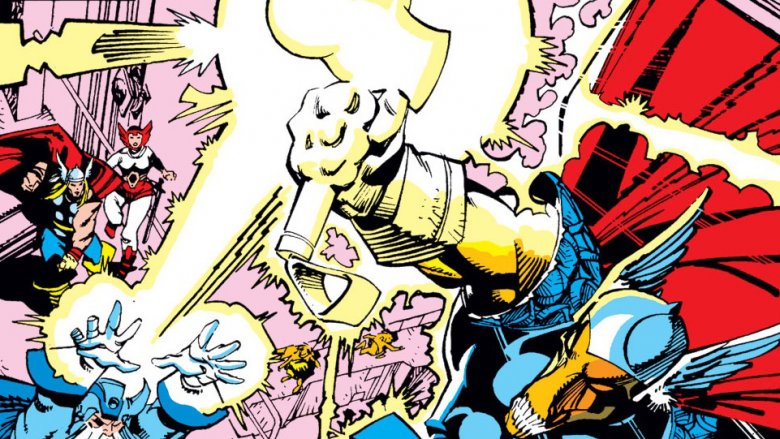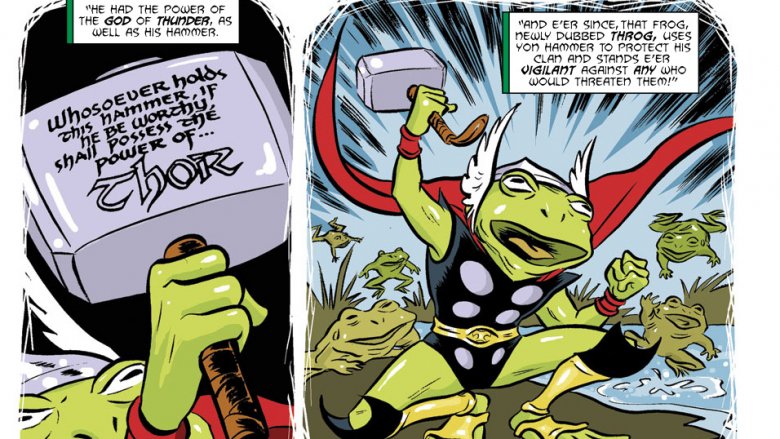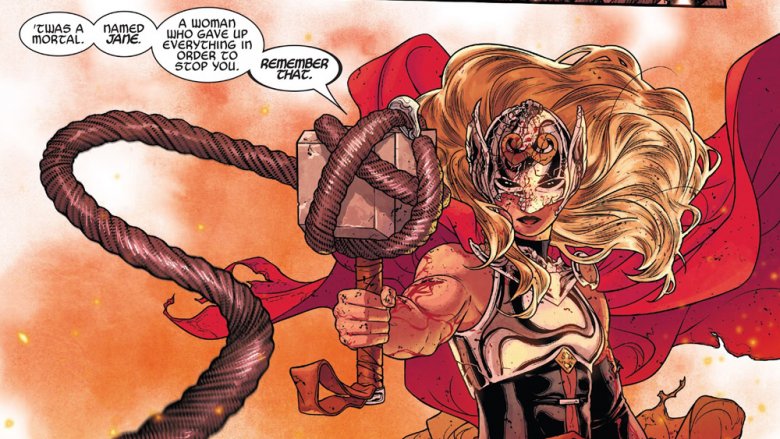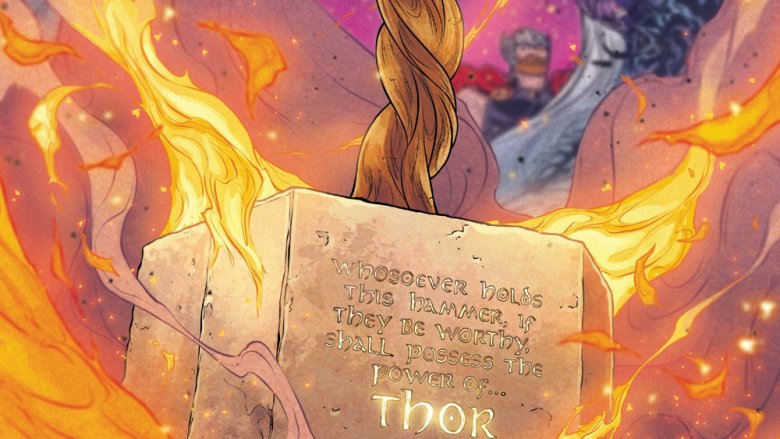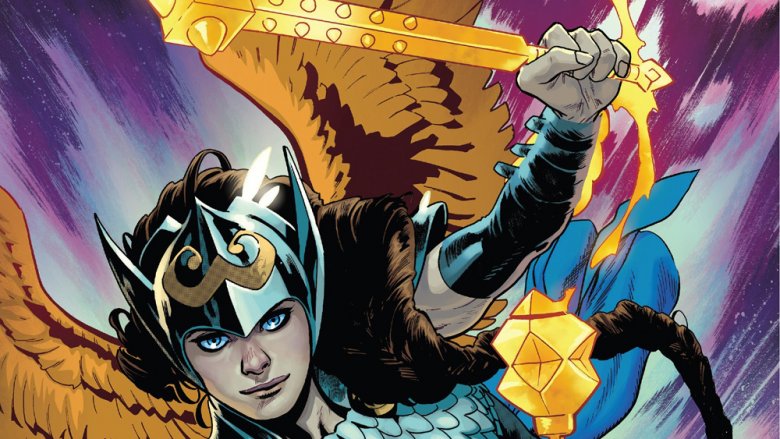Thor's Hammers Mjolnir And Stormbreaker Explained
If you're a fan of the Marvel Cinematic Universe — and let's be real here, who isn't? — then you already know the basics about Mjolnir, the unstoppable, relatively indestructible hammer of Thor, and Stormbreaker, its hopefully less destructible replacement. They're incredible, enchanted weapons forged by the dwarves of Nidavellir, capable of channeling Thor's godly powers, laying waste to his foes, and returning to his hand whenever he throws them. They're the centerpieces of some of the most exciting scenes in the entirety of the MCU, bringing thundering mythological action to the big screen.
The movies, however, only scratch the surface of what there is to know about these particular magic weapons. In the comics, and in the Norse mythology that they draw their inspiration from, Mjolnir is more than just a magic mallet, and Stormbreaker doesn't even belong to Thor. From their legendary origins and the enchantments that were added to the comics, all the way to the other Asgardian weapons that they're connected to, here's the full story of Mjolnir, Stormbreaker, and the god who wields them.
The mythological origin of Mjolnir
You might already know this, but according to our research, Stan Lee, Larry Lieber, and Jack Kirby didn't actually create Thor as an original concept for Marvel comics. It turns out that the god of thunder goes back way further than an issue of Journey into Mystery from 1962, and so does his thunderous hammer.
Joking aside, Mjolnir actually has a pretty interesting origin story in the 13th-century Prose Edda, and like most Norse mythology, it involves Loki causing trouble. In this case, he made a wager with a pair of dwarves named Brokkr and Sindri — you may know them from 2018's God of War — betting that they couldn't craft three magical items that were the equal of Asgard's three greatest treasures: a head of hair woven from gold that was given to Sif after Loki shaved her head; Skidbladnir, the greatest of all ships, which was large enough to carry all the gods but could be folded up to pocket size for convenience; and Gungnir, the spear of Odin, which could unfailingly strike any target.
To rise to the challenge, the blacksmithing dwarves set about working their forge and, despite Loki's interference — which in this case involved turning into a bug and biting Sindri on the eye — they crafted a trio of treasures of their own. First was Gullinbursti, a wild boar somehow made in a forge that could both run faster than a horse and glow in the dark. Second was Draupnir, a magic golden ring that would produce nine identical golden rings every nine nights. And third, of course, was Mjolnir, which turned out to be a pretty good hammer.
Accessories make the man (or god)
Mythologically speaking, Mjolnir was capable of blasting lightning bolts, returning to Thor's hand whenever he threw it, and striking so hard that its impact created the sound of thunder. It was not, however, flawless. When Loki bit Sindri's eye, the smith had to pause his work just long enough to wipe off the blood, so Mjolnir came out of the forge with a shorter handle than a mountain-shattering warhammer should have.
As a result, Thor could only wield it with one hand, and even he had trouble with it. In order to lift the weapon — a problem that he had to face long before Lee, Lieber, and Kirby added the enchantment about worthiness — he had to use yet another pair of magical accessories. The first was the Jarngreipr, a pair of gauntlets known as the "Iron Grippers," and the second was the Megingjord, a belt that doubled his already considerable strength. So if you thought getting hit by a god with a hammer would hurt, imagine getting clocked by two gods with hammers at the same time, and you'll have an idea of how the Frost Giants felt.
Over the years, Marvel has added or adapted most of the mythological stories behind the Norse gods for their version, so it's not surprising that both of those items exist in the comics. However, the Megingjord shows up rarely on the page, and in order to explain why Thor doesn't just wear it all the time to double his strength, Marvel's version, according to Thor #363, takes a pretty serious toll on the god of thunder. As Thor explains, the belt "drains me so severely that I shall scarce be able to walk when I remove it." It exists in the MCU, too — Happy Hogan mentions that it's among the items being packed up when the team moves out of Avengers Tower in Spider-Man: Homecoming.
Thor may have taken some inspiration from Shazam
Naturally, Marvel's version of Mjolnir first appeared in Journey into Mystery #83, loaded up with a few interesting spells to make for more exciting superhero comic stories. The first, of course, was the familiar enchantment by Odin that meant only the "worthy" could lift it and be granted the power of Thor.
For the other, though, it seems like the Marvel masterminds may have been taking some inspiration from a lightning-powered hero who was a little more recent than the Prose Edda. In the Golden Age of Comics, young Billy Batson discovered a wizard in a cave and said the magic word "SHAZAM!" to transform with a thunderous blast into Captain Marvel, the World's Mightiest Mortal! He was blessed with the strength of Hercules, the power of Zeus, and the ability to outsell Superman for most of the '40s. He even shared his power with his sidekick, Captain Marvel Jr., whose secret identity was Freddy Freeman, a young man whose injured leg led him to walk with a crutch.
Captain Marvel stopped being published in the '50s, though he would eventually come back as DC's Shazam, renamed for obvious reasons. In 1962, however, there was some interesting stuff going on with the god of thunder. Marvel's version of Thor was secretly Don Blake, a doctor whose injured leg led him to walk with a cane. He discovered a stout stick in a cave, and when he smacked it against the ground, it transformed him with a thunderous blast into Thor, the World's Mightiest Immortal! Blake was then blessed with the strength of Thor, the power of Thor, and ... well, you get the idea. Better still, the stick itself transformed into Mjolnir. Of course, whether the Marvel bullpen was actually trying to recapture the magic of Captain Marvel Adventures by giving it some of that hot Viking flavor is certainly up for debate.
Multiple people have picked up Mjolnir
Marvel's most enduring addition to their version of Mjolnir — aside from having it crafted from a mystical metal called Uru rather than iron worked by extremely talented dwarves — was the enchantment that granted the power of Thor to only those who were worthy of it.
Anyone who was worthy of it.
The two most prominent examples are Beta Ray Bill and Jane Foster, both of whom actually took the identity of Thor themselves, although in Bill's case it was only for a short time. We'll get to them in a moment, but there have been plenty of other characters to prove their worthiness to wield the hammer over the years, from Thor's fellow Avengers to an unexpected character from the Distinguished Competition.
The more notable examples include Steve Rogers, who first hefted the hammer when he was operating as "The Captain," and later lifted it in his more familiar identity of Captain America. Squirrel Girl also got her hands on the hammer and used it to stop a duplicate of herself from beating up the Marvel Universe in the appropriately titled The Unbeatable Squirrel Girl Beats Up the Marvel Universe, which proved that the duplicate was heading down the wrong path. The most eye-catching for crossover fans, however, came at the climax of JLA/Avengers, when Superman charged into battle wielding both Captain America's shield and Thor's hammer to save the day. Once the battle was over, however, Superman found himself unable to lift it up, leading Thor to explain that Odin, in his All-Fatherly wisdom, occasionally sees fit to suspend the enchantment for special occasions. Like, say, the last big Marvel/DC crossover.
The ballad of Stormbreaker and Beta Ray Bill
In 1983, Walt Simonson took over as the writer and artist of Thor with #337, and while it might be a stretch to say that he changed everything, he certainly brought in plenty of new stuff. The first big shift? Ditching Thor's human identity of Don Blake — who was not actually human, but had been created by Odin in order to teach his son humility — by making Thor a space horse.
Okay, it's slightly more complicated than that. While investigating something out in space, Thor encountered an alien warrior named Beta Ray Bill. In the fight, Thor lost his hammer, and thanks to yet another enchantment that caused him to revert back to Don Blake if he was out of contact with Mjolnir for more than 60 seconds, it turned back into Blake's walking stick. A very frustrated Bill grabbed the stick and smacked it against the wall, and readers suddenly learned that this strange new alien who definitely seemed like a bad guy is every bit as worthy as the guy with his name on the cover. Bill transformed into a new, sci-fi Thor, and was promptly whisked off to Asgard because Odin's summoning spell was looking for "Thor" and not "my son."
Over the next few issues, Bill was made to battle to the death against Thor to determine who would be the true god of thunder — which, if we're being honest here, is some pretty rough parenting from Odin the All-Father. In the end, though, Bill ended up saving Thor's life and proving himself to be a good and noble soul who just happened to look like a giant horse. He swore his loyalty to Thor as his "oath-brother," and to reward him, Odin had Eitri the dwarf craft a new hammer to be Mjolnir's equal: Stormbreaker. It was every bit as strong, had the same enchantment about worthiness, and the only big difference came in the aesthetics. Stormbreaker, while made of Uru, appeared golden and had one flat hammer-head and an ax-like blade on the other side.
Frogjolnir (no, really)
Beta Ray Bill isn't the only strange transformation that Thor underwent during Walt Simonson's five-year run. At one point in the comics, Thor found himself turned into a frog thanks to — let's say it all together now — Loki. While he was a frog, he got caught in a Secret of NIMH-esque war between New York City's frogs and the ravenous sewer rat population that was being controlled by a bad guy with low aspirations called the Piper. The whole issue was built around a struggle for Thor to recover his hammer, and when he did, he struck it against the ground and was thunderously transformed into ... a 6'6" frog dressed like Thor.
That's not the end of the frogs' story, though. While he was briefly amphibious, Thor spent some time hanging out with a frog named Puddlegulp, who it turned out was also a human transformed into a frog, because that's the kind of thing that happens when you're living in a universe full of wizards, ghosts, and ghost-wizards. At one point, however, Puddlegulp — who had the human name Simon Walterson, get it? — found a shard of Mjolnir that was chipped off by one of Thor's chariot-pulling goats. (They're named Toothgnasher and Toothgrinder, by the way.)
In an effort to save his fellow frogs, Puddlegulp lifted the shard, struck it against the ground, and became Throg, the frog of thunder. Unlike Thor's time as the thunder frog, Puddlegulp's version was still frog-sized, with a tiny Mjolnir to match. This hammer had all the abilities of the regular version, and was thus given the extremely on-the-nose name of "Frogjolnir."
The destruction of Mjolnir
In 2014, Thor came to the conclusion that he was no longer worthy to wield Mjolnir, and that lack of confidence became a self-fulfilling prophecy. While Thor was being glum about this turn of events — and getting his left arm chopped off by Malekith the Dark Elf in a pretty disastrous attempt at hammerless crime-fighting — Jane Foster, believing that there must always be a Thor to stand against evil, hefted the hammer herself and became the Mighty Thor.
For the next three years, Jane was Thor, but her tenure as the goddess of thunder came to crashing end when Mjolnir itself was destroyed. It happened during a battle with the Mangog, a creature that had come into being in a past era when Odin slaughtered an entire planet, and the pure vengeful hatred of its population coalesced into a nigh-unstoppable monster. The key word there, however, is "nigh." Jane did end up stopping the Mangog by chaining him to Mjolnir and hurling it into the heart of the sun.
As you may already know from science, the core of the sun is roughly 10,000 degrees Fahrenheit and contains a constant nuclear reaction that converts about 400,000,000 tons of matter into energy per second. That turns out to be about the level of force that you need in order to destroy a presumably "unbreakable" magic hammer. Mjolnir was vaporized, Jane retired from Thor-ing, and the Odinson once again took up his heroic exploits, using a series of substitute hammers crafted by a dwarf named Screwbeard. Sadly, due to a shortage of the mystical Uru metal from which the original Mjolnir had been crafted, none of the replacements were as good as the genuine article.
Mjolnir reborn
While Mjolnir was destroyed forever in 2018, it eventually made its return. But, c'mon, you knew that. This is comics, and it's only a matter of time before everyone comes back from the dead, including hammers. Besides, returning to Thor's hand is that thing's entire deal.
In this case, it happened during 2019's War of the Realms, a crossover event that, shockingly, was not Loki's fault. Instead, it was Malekith again, leading an invasion of Midgard (Earth) from the united forces of the other nine realms — and yes, we do mean the other nine. Marvel's version of Norse cosmology has a secret tenth realm, which is Heaven, the origin of which is an extremely complicated story that involves a real-world legal dispute. Anyway, at the climax of the story, Thor conjured up the God Tempest, a storm so powerful that it affected the sun itself, reforging Mjolnir and sending it crashing back to Earth.
The reborn Mjolnir was pretty recognizable as the original, with the exception of the handle. Rather than being the stout handle that Brokkr and Sindri made in their forge, Mjolnir II had a handle made of braided, natural-looking wood, presumably to bring it more into line visually with the version of Stormbreaker that moviegoing audiences would've seen in Avengers: Infinity War and Endgame. It also retained the worthiness enchantment, but Thor now viewed inherent worthiness as being far less important than the struggle that we all face to be better, declaring himself, along with his new hammer, to be the god of the unworthy.
The extended Asgardian arsenal
While they're easily the most notable ones, Mjolnir and Stormbreaker are far from the only Asgardian weapons to show up on the page. Most of the weapons that originated in mythology are present in the world of the comics. For example, there's Odin's spear, Gungnir, and Heimdall's magic sword, Hofund. Plus, there's Gram, the sword of the dragon-slaying Sigmund, and Laevateinn, Loki's sword whose name has the amazing translation of "Damage Twig." All these weapons are present in the comics, drawn from sources like the Edda and Ring of the Nibelung.
Others, however, are unique to the comics. Before he proved himself worthy of Mjolnir, Thor used a fearsome ax named Jarnbjorn, or "Iron Bear." Dragonfang, which appeared on the screen in Thor: Ragnarok, is the sword carried by Brunhilde the Valkyrie, so named because it was literally carved from a dragon's tooth. Skurge the Executioner was fond of using the Bloodaxe to behead his enemies, and its violent name is pretty self-explanatory. Fandral the Dashing, one of the trio of Thor's pals known as the Warriors Three, used a thin rapier-esque sword named Fimbuldraugr, which loosely translates to "Mighty Ghost." Not quite as delightful as "Damage Twig" for sure, but an evocative name considering Fandral's quickness and finesse with his blade.
There are other hammers, too. Loki once crafted a Mjolnir-like bludgeon named Stormcaster that he gave to the X-Men's resident weather-controlling goddess, Storm. Eric Masterson briefly took on the identity of Thor while the actual god was banished, and when the Odinson returned, Eric became a hero named Thunderstrike, wielding a magical mace of the same name. Most recently, Jane Foster took up a mystical Asgardian artifact named Undrjarn the All-Weapon. It had the ability to transform into any weapon that Jane required in her new job as a Valkyrie. Oh, and the Asgardian name? Fittingly enough, for a weapon unique to the comics page, it translates loosely to "Marvelous Weapon."
